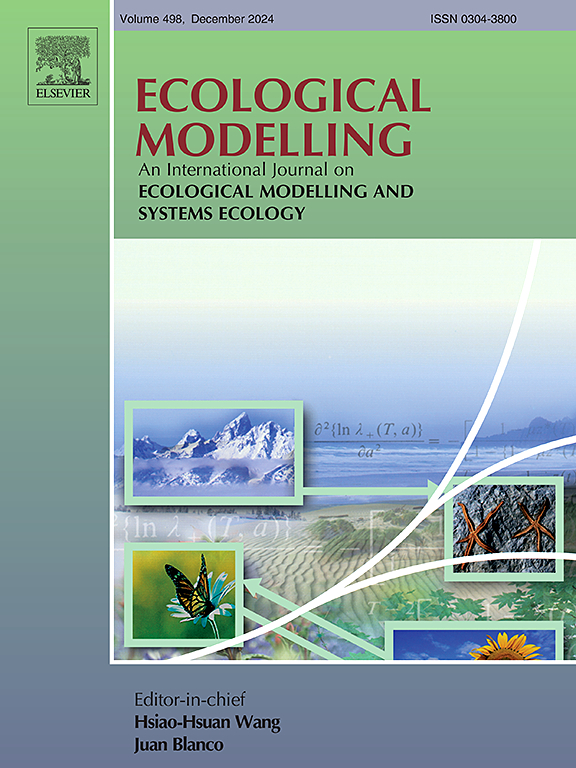Extreme capital breeding for giants: Effects of body size on humpback whale energy expenditure and fasting endurance
IF 2.6
3区 环境科学与生态学
Q2 ECOLOGY
引用次数: 0
Abstract
Baleen whales are extreme capital breeders, capable of fasting for more than half a year while migrating thousands of kilometres and nursing rapidly growing offspring that quadruple in body size over the same period. To understand this energetic conundrum, bioenergetic models that quantify the energy expenditure of baleen whales relative to their body energy reserves (body condition) are required. However, due to the difficulty in measuring the physiology and bioenergetics of large whales, few empirically informed models are available. Here we develop a bioenergetic model for humpback whales (Megaptera novaeangliae) off Western Australia to quantify their daily and seasonal energy expenditure over the breeding season. Specifically, we hypothesised that body size (length) would have a negative effect on the mass-specific energy expenditure of whales, and reduce female reproductive costs. A larger body size would also increase the absolute energy reserves, and hence fasting ability of humpback whales. To test this, we used a unique combination of field methodologies, including behavioural focal follows, aerial photogrammetry, and satellite tagging. To quantify the daily energetic cost of body maintenance, activity, somatic growth, and reproduction (gestation and lactation), we combined fine-scale behavioural and body morphometric data. Seasonal energy loss was estimated from changes in body condition, using aerial photogrammetry data. Migration timing and swim speed were calculated from satellite tag movement data. The resulting bioenergetic model showed that body size had a strong negative effect on the mass-specific energy expenditure of whales, and a positive effect on the fasting ability and residency time of juveniles and adults. Maternal body size had a positive effect on calf birth size and growth, so that calves of larger females reached their departure size quicker and begin their migration back to the Antarctic feeding grounds. The body condition loss during the breeding season declined with body size for juveniles (26.9-14.4%) and lactating females (28.3-7.8%), while adults maintained a constant loss (14.4-15.0%) by increasing their residency time. The ability of humpback whales to support such high seasonal energetic costs with only stored energy reserves highlights the energetic benefits that gigantism provides in these extreme capital breeders.
巨兽的极端资本繁殖:体型对座头鲸能量消耗和禁食耐力的影响
须鲸是极端的资本繁殖者,能够在迁徙数千公里的过程中禁食半年以上,哺育快速成长的后代,这些后代的体型在同一时期增长了四倍。为了理解这个能量难题,需要量化须鲸相对于身体能量储备(身体状况)的能量消耗的生物能量模型。然而,由于测量大型鲸鱼的生理和生物能量学的困难,很少有经验知情的模型可用。在这里,我们为西澳大利亚的座头鲸(Megaptera novaeangliae)开发了一个生物能量模型,以量化它们在繁殖季节的日常和季节性能量消耗。具体来说,我们假设体型(长度)会对鲸鱼的质量能量消耗产生负面影响,并降低雌性繁殖成本。更大的体型也会增加绝对能量储备,从而提高座头鲸的禁食能力。为了验证这一点,我们使用了独特的现场方法组合,包括行为焦点跟踪,航空摄影测量和卫星标记。为了量化身体维持、活动、身体生长和繁殖(妊娠和哺乳)的日常能量消耗,我们结合了精细尺度的行为和身体形态测量数据。利用航空摄影测量数据,从身体状况的变化估计季节性能量损失。根据卫星标签运动数据计算迁移时间和游动速度。由此建立的生物能量模型表明,体型对鲸鱼的质量比能量消耗有很强的负面影响,而对幼鲸和成年鲸的禁食能力和停留时间有积极影响。母亲的体型对幼崽的出生尺寸和生长有积极的影响,因此体型较大的雌性幼崽更快地达到出发的尺寸,并开始迁徙回南极的觅食地。幼鱼(26.9 ~ 14.4%)和哺乳期雌鱼(28.3 ~ 7.8%)的体况损失率随体型的增大而下降,而成虫(14.4 ~ 15.0%)的体况损失率随居住时间的增加而保持不变。座头鲸仅凭储存的能量储备就能维持如此高的季节性能量消耗,这突显了这些极端资本繁殖者的巨大优势。
本文章由计算机程序翻译,如有差异,请以英文原文为准。
求助全文
约1分钟内获得全文
求助全文
来源期刊

Ecological Modelling
环境科学-生态学
CiteScore
5.60
自引率
6.50%
发文量
259
审稿时长
69 days
期刊介绍:
The journal is concerned with the use of mathematical models and systems analysis for the description of ecological processes and for the sustainable management of resources. Human activity and well-being are dependent on and integrated with the functioning of ecosystems and the services they provide. We aim to understand these basic ecosystem functions using mathematical and conceptual modelling, systems analysis, thermodynamics, computer simulations, and ecological theory. This leads to a preference for process-based models embedded in theory with explicit causative agents as opposed to strictly statistical or correlative descriptions. These modelling methods can be applied to a wide spectrum of issues ranging from basic ecology to human ecology to socio-ecological systems. The journal welcomes research articles, short communications, review articles, letters to the editor, book reviews, and other communications. The journal also supports the activities of the [International Society of Ecological Modelling (ISEM)](http://www.isemna.org/).
 求助内容:
求助内容: 应助结果提醒方式:
应助结果提醒方式:


